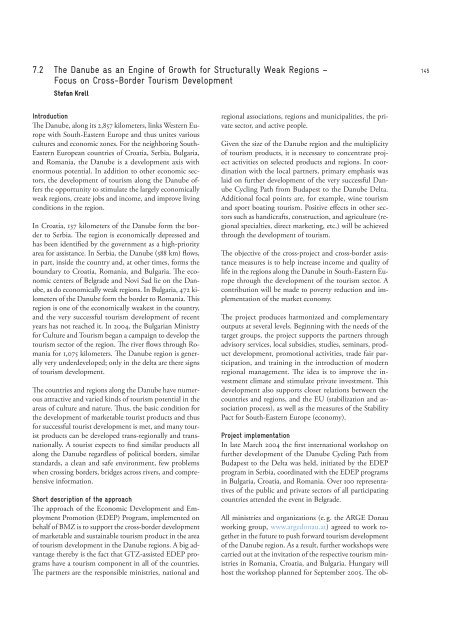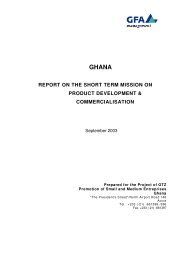Local/Regional Economic Development in South ... - Value Chains
Local/Regional Economic Development in South ... - Value Chains
Local/Regional Economic Development in South ... - Value Chains
Create successful ePaper yourself
Turn your PDF publications into a flip-book with our unique Google optimized e-Paper software.
7.2 The Danube as an Eng<strong>in</strong>e of Growth for Structurally Weak Regions –<br />
Focus on Cross-Border Tourism <strong>Development</strong><br />
Stefan Krell<br />
Introduction<br />
The Danube, along its 2,857 kilometers, l<strong>in</strong>ks Western Europe<br />
with <strong>South</strong>-Eastern Europe and thus unites various<br />
cultures and economic zones. For the neighbor<strong>in</strong>g <strong>South</strong>-<br />
Eastern European countries of Croatia, Serbia, Bulgaria,<br />
and Romania, the Danube is a development axis with<br />
enormous potential. In addition to other economic sectors,<br />
the development of tourism along the Danube offers<br />
the opportunity to stimulate the largely economically<br />
weak regions, create jobs and <strong>in</strong>come, and improve liv<strong>in</strong>g<br />
conditions <strong>in</strong> the region.<br />
In Croatia, 137 kilometers of the Danube form the border<br />
to Serbia. The region is economically depressed and<br />
has been identified by the government as a high-priority<br />
area for assistance. In Serbia, the Danube (588 km) flows,<br />
<strong>in</strong> part, <strong>in</strong>side the country and, at other times, forms the<br />
boundary to Croatia, Romania, and Bulgaria. The economic<br />
centers of Belgrade and Novi Sad lie on the Danube,<br />
as do economically weak regions. In Bulgaria, 472 kilometers<br />
of the Danube form the border to Romania. This<br />
region is one of the economically weakest <strong>in</strong> the country,<br />
and the very successful tourism development of recent<br />
years has not reached it. In 2004, the Bulgarian M<strong>in</strong>istry<br />
for Culture and Tourism began a campaign to develop the<br />
tourism sector of the region. The river flows through Romania<br />
for 1,075 kilometers. The Danube region is generally<br />
very underdeveloped; only <strong>in</strong> the delta are there signs<br />
of tourism development.<br />
The countries and regions along the Danube have numerous<br />
attractive and varied k<strong>in</strong>ds of tourism potential <strong>in</strong> the<br />
areas of culture and nature. Thus, the basic condition for<br />
the development of marketable tourist products and thus<br />
for successful tourist development is met, and many tourist<br />
products can be developed trans-regionally and transnationally.<br />
A tourist expects to f<strong>in</strong>d similar products all<br />
along the Danube regardless of political borders, similar<br />
standards, a clean and safe environment, few problems<br />
when cross<strong>in</strong>g borders, bridges across rivers, and comprehensive<br />
<strong>in</strong>formation.<br />
Short description of the approach<br />
The approach of the <strong>Economic</strong> <strong>Development</strong> and Employment<br />
Promotion (EDEP) Program, implemented on<br />
behalf of BMZ is to support the cross-border development<br />
of marketable and susta<strong>in</strong>able tourism product <strong>in</strong> the area<br />
of tourism development <strong>in</strong> the Danube regions. A big advantage<br />
thereby is the fact that GTZ-assisted EDEP programs<br />
have a tourism component <strong>in</strong> all of the countries.<br />
The partners are the responsible m<strong>in</strong>istries, national and<br />
regional associations, regions and municipalities, the private<br />
sector, and active people.<br />
Given the size of the Danube region and the multiplicity<br />
of tourism products, it is necessary to concentrate project<br />
activities on selected products and regions. In coord<strong>in</strong>ation<br />
with the local partners, primary emphasis was<br />
laid on further development of the very successful Danube<br />
Cycl<strong>in</strong>g Path from Budapest to the Danube Delta.<br />
Additional focal po<strong>in</strong>ts are, for example, w<strong>in</strong>e tourism<br />
and sport boat<strong>in</strong>g tourism. Positive effects <strong>in</strong> other sectors<br />
such as handicrafts, construction, and agriculture (regional<br />
specialties, direct market<strong>in</strong>g, etc.) will be achieved<br />
through the development of tourism.<br />
The objective of the cross-project and cross-border assistance<br />
measures is to help <strong>in</strong>crease <strong>in</strong>come and quality of<br />
life <strong>in</strong> the regions along the Danube <strong>in</strong> <strong>South</strong>-Eastern Europe<br />
through the development of the tourism sector. A<br />
contribution will be made to poverty reduction and implementation<br />
of the market economy.<br />
The project produces harmonized and complementary<br />
outputs at several levels. Beg<strong>in</strong>n<strong>in</strong>g with the needs of the<br />
target groups, the project supports the partners through<br />
advisory services, local subsidies, studies, sem<strong>in</strong>ars, product<br />
development, promotional activities, trade fair participation,<br />
and tra<strong>in</strong><strong>in</strong>g <strong>in</strong> the <strong>in</strong>troduction of modern<br />
regional management. The idea is to improve the <strong>in</strong>vestment<br />
climate and stimulate private <strong>in</strong>vestment. This<br />
development also supports closer relations between the<br />
countries and regions, and the EU (stabilization and association<br />
process), as well as the measures of the Stability<br />
Pact for <strong>South</strong>-Eastern Europe (economy).<br />
Project implementation<br />
In late March 2004 the first <strong>in</strong>ternational workshop on<br />
further development of the Danube Cycl<strong>in</strong>g Path from<br />
Budapest to the Delta was held, <strong>in</strong>itiated by the EDEP<br />
program <strong>in</strong> Serbia, coord<strong>in</strong>ated with the EDEP programs<br />
<strong>in</strong> Bulgaria, Croatia, and Romania. Over 100 representatives<br />
of the public and private sectors of all participat<strong>in</strong>g<br />
countries attended the event <strong>in</strong> Belgrade.<br />
All m<strong>in</strong>istries and organizations (e. g. the ARGE Donau<br />
work<strong>in</strong>g group, www.argedonau.at) agreed to work together<br />
<strong>in</strong> the future to push forward tourism development<br />
of the Danube region. As a result, further workshops were<br />
carried out at the <strong>in</strong>vitation of the respective tourism m<strong>in</strong>istries<br />
<strong>in</strong> Romania, Croatia, and Bulgaria. Hungary will<br />
host the workshop planned for September 2005. The ob-<br />
1 5



